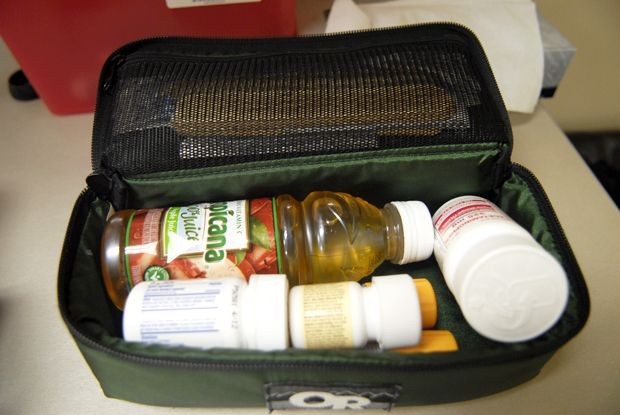 Nearly a hundred years after its discovery, the cost of insulin — a life-saving drug for diabetics — has continued to rise, leaving many daily users of the drug weary.
Nearly a hundred years after its discovery, the cost of insulin — a life-saving drug for diabetics — has continued to rise, leaving many daily users of the drug weary.
In November, the American Diabetes Association called upon lawmakers to investigate the medication’s price increase, and to ensure the drug remains accessible, citing a 48 percent increase in the annual cost of diabetes, gestational diabetes and prediabetes over the course of five years in the U.S. The yearly cost in 2012 alone was $322 billion.
At the University of Minnesota, concerns surrounding the drug’s expense — especially to low-income or uninsured patients — remain prevalent.
Betsy Seaquist, a University diabetes researcher and professor in the Department of Medicine, works directly with diabetic patients and often has to switch them to cheaper types of insulin.
Seaquist said insulin costs depend on health insurance and the kind of insulin prescribed. Older types of insulin can be cheaper, but don’t control blood sugar levels as well as newer varieties — which can be over $100 more expensive per 10 milliliter vial.
“The new insulins that have the advantage of ease of use and probably lower risk of [low blood sugar] are much more expensive,” she said. “Even the old insulins have gone up in price in recent years.”
She said she doesn’t know why prices have risen, especially when so many need it to live.
“When you can’t afford it, it’s just tragic,” she said.
Seaquist said she often has to discuss the price of insulin and alternate options with patients.
“I have needed to use less expensive insulins for patients than I would otherwise want to because of the expense issues,” she said.
There are many medications to treat diabetes, Seaquist said, but those with Type 1 have to take insulin because their bodies cannot make it.
In Type 2 diabetes — the most common in the U.S. — the body doesn’t make the right amount of insulin or use it appropriately, and many patients take supplemental insulin.
To take the drug, diabetics have switched over time from using a syringe to pens and pumps that set dosages more accurately, she said.
Trevor Omann, a junior genetics major, was diagnosed with Type 1 diabetes in fifth grade and grew up treating the disease with insulin.
Omann — who works as a clinical research assistant in the Department of Pediatrics Endocrinology division — is a counselor at a camp for children with diabetes and started a student group this semester called the American Diabetes Association College Connect.
“The goal of the club is to provide a support group for diabetics on campus,” he said. “And to also help educate students about diabetes.”
Omann said Type 2 diabetes can be caused by obesity and college students are still at risk for diabetes as they form lifestyle habits that will affect their health in the long-term.
“If we can correct people’s lifestyle habits, we can prevent Type 2 diabetes, hopefully, in the future,” Omann said.
Though he keeps his diabetes under control, Omann said carting around the supplies to do so can make traveling frustrating.
“You’re dependent on your insulin and all of the supplies that you need to inject that insulin,” he said. “They require a lot of supplies, so wherever you go, you have to carry them.”
The cost for supplies adds to rising insulin costs, he said. Omann is still under his mom’s health insurance — which covers his insulin and most supplies — depending on what deals the insurance company offers in partnership with medical suppliers.
“Cost of insulin is obviously really important,” he said. “But there’s a lot of other costs that go into it too.”
Kylee Funk, a clinical faculty member in the College of Pharmacy, meets with patients to optimize their medication regimens and teaches a course on diabetes.
“I have worked with patients that have difficulty affording their insulin,” Funk said, adding patients often ration medications to have enough.
She said there is likely more rationing or skipping doses than healthcare providers are aware of. “I’ve seen people get infections that likely could have been prevented from optimal use of their insulin.”
Funk said patients also opt to take insulin over other prescribed medications because insulin acts faster.
“For instance, I’ve seen patients choose to take their insulin, which is expensive, and they can’t afford their blood pressure medication,” she said. “Since they might not … feel any symptoms of blood pressure, it might not feel so concerning.”
Omann said if he had to ration out his insulin supply each month, it would require a low-carb, strict meal plan.
“You would have continually high blood sugar,” he said. “High blood sugar is really acidic to your body … eventually you would start to get sick.”
High blood sugar causes a diabetic to feel the need to urinate constantly, and often result in other undesirable feelings — like dehydration, hunger and urge to vomit, he said.
“The demand’s there. People will pay,” Omann said. “It sucks for people who actually need it and can’t afford insurance.”
















